Pricing Guides & Dictionary of Makers Marks for Antiques & Collectibles

A few examples of appraisal values for
BARBED WIRE
Search our price guide for your own treasures
-
 WESTERN STEVE WALDOCK COWHIDE HORNS
WESTERN STEVE WALDOCK COWHIDE HORNS WALL MIRRORWestern style wall mirror, cowhide-clad frame, with nail head and barbed wire accents, cattle horn mount over beveled mirror plate, signed S. Waldock (Steve Waldock, Australia, 20th/ 21st c.) verso, approx 32"h, 40.75"w, 32lbs
WESTERN STEVE WALDOCK COWHIDE HORNS
WESTERN STEVE WALDOCK COWHIDE HORNS WALL MIRRORWestern style wall mirror, cowhide-clad frame, with nail head and barbed wire accents, cattle horn mount over beveled mirror plate, signed S. Waldock (Steve Waldock, Australia, 20th/ 21st c.) verso, approx 32"h, 40.75"w, 32lbs -
 BILL NASOGALUAK ??? ?????? (b.
BILL NASOGALUAK ??? ?????? (b. 1953), Tuktoyaktuk BEAR TANGLED IN BARBED WIRE unsigned 6 x 15 x 7.5 in — 15.2 x 38.1 x 19.1 cm
BILL NASOGALUAK ??? ?????? (b.
BILL NASOGALUAK ??? ?????? (b. 1953), Tuktoyaktuk BEAR TANGLED IN BARBED WIRE unsigned 6 x 15 x 7.5 in — 15.2 x 38.1 x 19.1 cm -
 ROGER SHIMOMURA CERAMIC BARBED WIRE
ROGER SHIMOMURA CERAMIC BARBED WIRE & ASSORTED OBJECTSRoger Shimomura (Kansas, b. 1939) Glazed ceramic barbed wire 8 1/2" long Barbed wire is a repeated motif in the work of Roger Shimomura, alluding to the United States' internment of 120,000 Japanese-Americans and others of Japanese descent in ten concentration camps during WWII. Not signed. The small ceramic piece is offered alongside a trove of Shimomura objects, including: - Marker-signed 1984 poster - Marker-signed canvas tote bag - Signed copy of The Prints of Roger Shimomura: A Catalogue Raisonne, 1968-2005 (2007) - Signed copy of Shadows of Minidoka: Paintings and Collections of Roger Shimomura (2011) - Assorted Shimomura exhibition mailers, graphics, and write-ups Provenance : From the collection of one of Shimomura's longtime colleagues in the art department at the University of Kansas. Condition The ceramic has several chips and repaired breaks. Light foxing to the poster and mild wear and grime to the tote bag. The books are each in very good condition.
ROGER SHIMOMURA CERAMIC BARBED WIRE
ROGER SHIMOMURA CERAMIC BARBED WIRE & ASSORTED OBJECTSRoger Shimomura (Kansas, b. 1939) Glazed ceramic barbed wire 8 1/2" long Barbed wire is a repeated motif in the work of Roger Shimomura, alluding to the United States' internment of 120,000 Japanese-Americans and others of Japanese descent in ten concentration camps during WWII. Not signed. The small ceramic piece is offered alongside a trove of Shimomura objects, including: - Marker-signed 1984 poster - Marker-signed canvas tote bag - Signed copy of The Prints of Roger Shimomura: A Catalogue Raisonne, 1968-2005 (2007) - Signed copy of Shadows of Minidoka: Paintings and Collections of Roger Shimomura (2011) - Assorted Shimomura exhibition mailers, graphics, and write-ups Provenance : From the collection of one of Shimomura's longtime colleagues in the art department at the University of Kansas. Condition The ceramic has several chips and repaired breaks. Light foxing to the poster and mild wear and grime to the tote bag. The books are each in very good condition. -
 JAMES E. HAZELEY (AMERICAN
JAMES E. HAZELEY (AMERICAN 1934-2013) A WOOD SCULPTURE,...JAMES E. HAZELEY (American 1934-2013) A WOOD SCULPTURE, "Ruby Throated Hummingbird ? (Archilochus Colubris) with Japanese Honeysuckle (Lonicera Japonica)," 1988, painted wood and barbed wire, titled, signed and dated under plinth base. Height: 8 1/4" Diameter: 5" Condition: Some cracked leaves near vine, but overall in good to very good condition, wear commensurate with age. Simpson Galleries strongly encourages in-person inspection of items by the bidder. Statements by Simpson Galleries regarding the condition of objects are for guidance only and should not be relied upon as statements of fact and do not constitute a representation, warranty, or assumption of liability by Simpson Galleries. All lots offered are sold "AS IS."
JAMES E. HAZELEY (AMERICAN
JAMES E. HAZELEY (AMERICAN 1934-2013) A WOOD SCULPTURE,...JAMES E. HAZELEY (American 1934-2013) A WOOD SCULPTURE, "Ruby Throated Hummingbird ? (Archilochus Colubris) with Japanese Honeysuckle (Lonicera Japonica)," 1988, painted wood and barbed wire, titled, signed and dated under plinth base. Height: 8 1/4" Diameter: 5" Condition: Some cracked leaves near vine, but overall in good to very good condition, wear commensurate with age. Simpson Galleries strongly encourages in-person inspection of items by the bidder. Statements by Simpson Galleries regarding the condition of objects are for guidance only and should not be relied upon as statements of fact and do not constitute a representation, warranty, or assumption of liability by Simpson Galleries. All lots offered are sold "AS IS." -
 1ST EDITION BEFORE BARBED WIRE BY
1ST EDITION BEFORE BARBED WIRE BY MARK H. BROWNFor your consideration is this First Edition Before Barbed Wire by Mark H. Brown. This book is a gem of Montana history, with 124 photographs from the famous L. A Huffman. Showing original photos some from horseback. As an early rancher, Huffman had been a part of the life he later recorded with his camera. His studies were not stilted photographs posed for a visiting photographer, but of candid shots of working people who considered him one of themselves. Sometimes Huffman rode with a roundup or followed a herd of sheep for days before he caught the picture he wanted. His was a golden opportunity to record the early life on the Plains, and he exploited it to the fullest. Huffman caught and preserved the spirit of life on the unfenced Montana ranges in the days before barbed wire. This book is in good display condition with some wear and tear to the book cover but the integrity of the book is in excellent condition. The measurements of this book are11 1/4" x 8 3/4".
1ST EDITION BEFORE BARBED WIRE BY
1ST EDITION BEFORE BARBED WIRE BY MARK H. BROWNFor your consideration is this First Edition Before Barbed Wire by Mark H. Brown. This book is a gem of Montana history, with 124 photographs from the famous L. A Huffman. Showing original photos some from horseback. As an early rancher, Huffman had been a part of the life he later recorded with his camera. His studies were not stilted photographs posed for a visiting photographer, but of candid shots of working people who considered him one of themselves. Sometimes Huffman rode with a roundup or followed a herd of sheep for days before he caught the picture he wanted. His was a golden opportunity to record the early life on the Plains, and he exploited it to the fullest. Huffman caught and preserved the spirit of life on the unfenced Montana ranges in the days before barbed wire. This book is in good display condition with some wear and tear to the book cover but the integrity of the book is in excellent condition. The measurements of this book are11 1/4" x 8 3/4". -
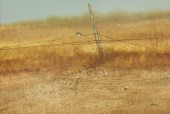 RAUL GUTIERREZ (TX, B.1935) QUAIL
RAUL GUTIERREZ (TX, B.1935) QUAIL WATERCOLORFramed watercolor and gouache painting on board, Quail on Barbed Wire, signed lower right Gutierrez (Raul Gutierrez, Texas, b.1935), sight: approx 15.5"h, 23.5"w, overall: approx 24.5"h, 32.5"w, 9.25lbs
RAUL GUTIERREZ (TX, B.1935) QUAIL
RAUL GUTIERREZ (TX, B.1935) QUAIL WATERCOLORFramed watercolor and gouache painting on board, Quail on Barbed Wire, signed lower right Gutierrez (Raul Gutierrez, Texas, b.1935), sight: approx 15.5"h, 23.5"w, overall: approx 24.5"h, 32.5"w, 9.25lbs -
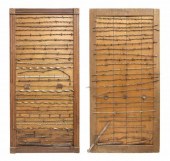 (2) TEXAS BARBED WIRE DISPLAY
(2) TEXAS BARBED WIRE DISPLAY BOARDS(lot of 2) Texas barbed wire display boards with 50 displayed wire pieces in addition to several railroad spikes and square nail, largest board approx. 43"h, 20.75"w, total: 20lbs
(2) TEXAS BARBED WIRE DISPLAY
(2) TEXAS BARBED WIRE DISPLAY BOARDS(lot of 2) Texas barbed wire display boards with 50 displayed wire pieces in addition to several railroad spikes and square nail, largest board approx. 43"h, 20.75"w, total: 20lbs -
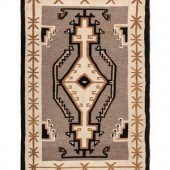 Navajo Crystal Pattern Weaving /
Navajo Crystal Pattern Weaving / Rug second quarter 20th century woven in a natural palette with central geometric design, four anchor points near corners, and a stylized barbed wire design border 81-1/2 x 52 inches Eiteljorg Museum of American Indians and Western Art
Navajo Crystal Pattern Weaving /
Navajo Crystal Pattern Weaving / Rug second quarter 20th century woven in a natural palette with central geometric design, four anchor points near corners, and a stylized barbed wire design border 81-1/2 x 52 inches Eiteljorg Museum of American Indians and Western Art -
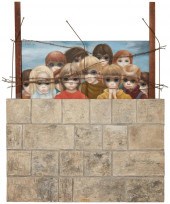 MARGARET KEANE, (B. 1927), "THE
MARGARET KEANE, (B. 1927), "THE BERLIN WALL," 1964, OIL ON CANVAS WITH ASSEMBLAGE OF WOOD AND BARBED WIRE, 61.75" H X 51.25" WMargaret Keane, (b. 1927) "The Berlin Wall," 1964 Oil on canvas with assemblage of wood and barbed wire Signed and dated upper left: Keane; with name plaque affixed lower center: Walter Keane 61.75" H x 51.25" W Provenance: Triton Museum of Art, Santa Clara, CA Exhibitions: Laguna Beach Art Museum, "Margaret Keane and Keaneabilia," July 30-DEcember 31, 2000 Notes: Margaret Keane is an internationally acclaimed artist, but especially known for her "big eyes" paintings. The large eyes that she painted onto her figures not only intrigued those who viewed her works, but it also spoke to them through a deeper meaning. Keane once said, ""The eyes I draw on my children are an expression of my own deepest feelings. Eyes are windows of the soul."One of Margaret Keane's more famous works is "The Berlin Wall," painted in 1964, three years after the Berlin Wall was built in August 1961. This painting exhibits ten small children grouped on the other side of a wall and barbed wire. Keane is placing the viewer not only on the opposite side of the wall from the children, but the most striking part of this work is the children's big eyes looking directly at the viewer. It is haunting yet one of her most compelling images. With her signature eyes and artistic style of using light, scale, and tone, she creates a piece that speaks volumes about the current political state at the time through her artistic value. Originally signed by Walter Keane. His name was painted out by Margaret Keane after the trial of 1985. This painting was featured in the Travel Channel series, Mysteries at the Museum, series 11, episode 10: "Big Eyes and More" October 20, 2016 This lot is accompanied by a set of Margaret Keane Books. "MDH Margaret Keane," by Elton Fiscus-Powell and Johnson Meyers, and "Walter Keane," by Eric Shneider and Johnson Meyers. Oil on canvas with assemblage of wood and barbed wire Dimensions: 61.75" H x 51.25" W Provenance: Triton Museum of Art, Santa Clara, CA
MARGARET KEANE, (B. 1927), "THE
MARGARET KEANE, (B. 1927), "THE BERLIN WALL," 1964, OIL ON CANVAS WITH ASSEMBLAGE OF WOOD AND BARBED WIRE, 61.75" H X 51.25" WMargaret Keane, (b. 1927) "The Berlin Wall," 1964 Oil on canvas with assemblage of wood and barbed wire Signed and dated upper left: Keane; with name plaque affixed lower center: Walter Keane 61.75" H x 51.25" W Provenance: Triton Museum of Art, Santa Clara, CA Exhibitions: Laguna Beach Art Museum, "Margaret Keane and Keaneabilia," July 30-DEcember 31, 2000 Notes: Margaret Keane is an internationally acclaimed artist, but especially known for her "big eyes" paintings. The large eyes that she painted onto her figures not only intrigued those who viewed her works, but it also spoke to them through a deeper meaning. Keane once said, ""The eyes I draw on my children are an expression of my own deepest feelings. Eyes are windows of the soul."One of Margaret Keane's more famous works is "The Berlin Wall," painted in 1964, three years after the Berlin Wall was built in August 1961. This painting exhibits ten small children grouped on the other side of a wall and barbed wire. Keane is placing the viewer not only on the opposite side of the wall from the children, but the most striking part of this work is the children's big eyes looking directly at the viewer. It is haunting yet one of her most compelling images. With her signature eyes and artistic style of using light, scale, and tone, she creates a piece that speaks volumes about the current political state at the time through her artistic value. Originally signed by Walter Keane. His name was painted out by Margaret Keane after the trial of 1985. This painting was featured in the Travel Channel series, Mysteries at the Museum, series 11, episode 10: "Big Eyes and More" October 20, 2016 This lot is accompanied by a set of Margaret Keane Books. "MDH Margaret Keane," by Elton Fiscus-Powell and Johnson Meyers, and "Walter Keane," by Eric Shneider and Johnson Meyers. Oil on canvas with assemblage of wood and barbed wire Dimensions: 61.75" H x 51.25" W Provenance: Triton Museum of Art, Santa Clara, CA -
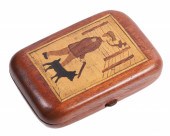 A wood tobacco box with inlay
A wood tobacco box with inlay decoration on both sides of a man behind barbed wire walking with a dog and walking stick on one side and running out of the barbed wire area on the other, possibly made by a prisoner of war.
A wood tobacco box with inlay
A wood tobacco box with inlay decoration on both sides of a man behind barbed wire walking with a dog and walking stick on one side and running out of the barbed wire area on the other, possibly made by a prisoner of war. -
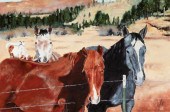 GEORGE STUMPFF, HORSES BARBED
GEORGE STUMPFF, HORSES BARBED WIREGeorge Stumpff, (1949 - 2019) Horses Barbed Wire, oil on canvas signed lower right: G. STUMPFF oil on canvas Dimensions: 24 x 36 in. (61 x 91.4 cm.) Provenance: Private Collection, New Mexico
GEORGE STUMPFF, HORSES BARBED
GEORGE STUMPFF, HORSES BARBED WIREGeorge Stumpff, (1949 - 2019) Horses Barbed Wire, oil on canvas signed lower right: G. STUMPFF oil on canvas Dimensions: 24 x 36 in. (61 x 91.4 cm.) Provenance: Private Collection, New Mexico -
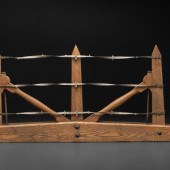 A Salesman Sample Barbed Wire Fence
A Salesman Sample Barbed Wire Fence Washburn and Moen Company, Worcester, Massachusetts, 19th Century base faintly stenciled in red paint A Sample Of / Steel Barb Fence / From Washburn & Moen Mfg. Co. Worcester Mass. Height 18 x width 36 x depth 3 3/8 inches. American industrialist Ichabod Washburn (1798–1868) established his first business, a woolen machinery factory, in Worcester in 1820. Throughout the 1820s, Washburn explored the manufacture of card wire at a factory in Northville, and by 1834, he consolidated these two enterprises at a new facility on Grove Street across from Salisbury’s Pond, where he made piano wire, wire for fences, and related products. By 1850, Washburn’s son-in-law became a partner in the firm, known by that time as the Washburn and Moen Manufacturing Company. Under their stead, Washburn and Moen enjoyed robust growth, becoming the largest wire mill in the world by 1865.
A Salesman Sample Barbed Wire Fence
A Salesman Sample Barbed Wire Fence Washburn and Moen Company, Worcester, Massachusetts, 19th Century base faintly stenciled in red paint A Sample Of / Steel Barb Fence / From Washburn & Moen Mfg. Co. Worcester Mass. Height 18 x width 36 x depth 3 3/8 inches. American industrialist Ichabod Washburn (1798–1868) established his first business, a woolen machinery factory, in Worcester in 1820. Throughout the 1820s, Washburn explored the manufacture of card wire at a factory in Northville, and by 1834, he consolidated these two enterprises at a new facility on Grove Street across from Salisbury’s Pond, where he made piano wire, wire for fences, and related products. By 1850, Washburn’s son-in-law became a partner in the firm, known by that time as the Washburn and Moen Manufacturing Company. Under their stead, Washburn and Moen enjoyed robust growth, becoming the largest wire mill in the world by 1865. -
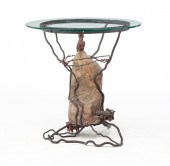 CONTEMPORARY TABLE BY JOHN ZAN.
CONTEMPORARY TABLE BY JOHN ZAN. American, 2nd half-20th century. Painted iron wrapped around a large stone with a train ascending the around center, barbed wire wrapped around near the top of the stone and a small finial rendering of "End of the Trail" by James Earle Fraser at the top of the stone. Round glass top.28.5"h. 28"dia.
CONTEMPORARY TABLE BY JOHN ZAN.
CONTEMPORARY TABLE BY JOHN ZAN. American, 2nd half-20th century. Painted iron wrapped around a large stone with a train ascending the around center, barbed wire wrapped around near the top of the stone and a small finial rendering of "End of the Trail" by James Earle Fraser at the top of the stone. Round glass top.28.5"h. 28"dia. -
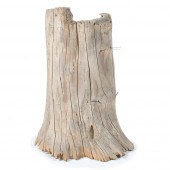 LARGE TREE STUMP WITH INGROWN
LARGE TREE STUMP WITH INGROWN BARBED WIRE 40"H X 28"W X 14 1/2"DLarge tree stump with ingrown barbed wire, Provenance: From a private collector in Zionsville / Indianapolis. Dimensions: 40"H x 28"W x 14 1/2"D
LARGE TREE STUMP WITH INGROWN
LARGE TREE STUMP WITH INGROWN BARBED WIRE 40"H X 28"W X 14 1/2"DLarge tree stump with ingrown barbed wire, Provenance: From a private collector in Zionsville / Indianapolis. Dimensions: 40"H x 28"W x 14 1/2"D -
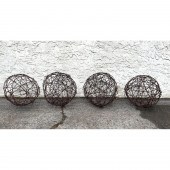 Set 4 Barbed Wire Ball Garden
Set 4 Barbed Wire Ball Garden sculptures Dimensions: H: 18 inches: W: 18 inches: D: 18 inches --- Condition: rust.
Set 4 Barbed Wire Ball Garden
Set 4 Barbed Wire Ball Garden sculptures Dimensions: H: 18 inches: W: 18 inches: D: 18 inches --- Condition: rust. -
 FLORENCIO MOLENA CAMPOS
FLORENCIO MOLENA CAMPOS (CA/ARGENTINA, 1891-1959) Un Gaucho, gouache and colored pencil on paperboard, signed upper right and dated 1956. Depicts a cowboy on horseback with his dog in the lead, a pair of oxen behind, traveling a desolate landscape, along a barbed wire fence line. In a black painted carved wood Mexican frame, matted, under plexi, OS: 27 1/2" x 36 1/2", SS: 16 1/4" x 25 1/4", fine condition.
FLORENCIO MOLENA CAMPOS
FLORENCIO MOLENA CAMPOS (CA/ARGENTINA, 1891-1959) Un Gaucho, gouache and colored pencil on paperboard, signed upper right and dated 1956. Depicts a cowboy on horseback with his dog in the lead, a pair of oxen behind, traveling a desolate landscape, along a barbed wire fence line. In a black painted carved wood Mexican frame, matted, under plexi, OS: 27 1/2" x 36 1/2", SS: 16 1/4" x 25 1/4", fine condition. -
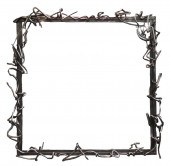 MATT EVALD JOHNSON INDUSTRIAL STEEL
MATT EVALD JOHNSON INDUSTRIAL STEEL ROD MIRROR Massachusetts,b.1964Fabricated from steel rod emulating curved barbed wire.
MATT EVALD JOHNSON INDUSTRIAL STEEL
MATT EVALD JOHNSON INDUSTRIAL STEEL ROD MIRROR Massachusetts,b.1964Fabricated from steel rod emulating curved barbed wire. -
 LG JOSZI ARPAD KOPPAY PORTRAIT
LG JOSZI ARPAD KOPPAY PORTRAIT PAINTING Austria,1859-1927Portrait of John W. Gates, an American industrialist and promoter of barbed wire, dressed in a suit and fur coat. Koppay was formally trained as an architect before turning to art full time and received in honorable mention at the 1888 Paris Salon.
LG JOSZI ARPAD KOPPAY PORTRAIT
LG JOSZI ARPAD KOPPAY PORTRAIT PAINTING Austria,1859-1927Portrait of John W. Gates, an American industrialist and promoter of barbed wire, dressed in a suit and fur coat. Koppay was formally trained as an architect before turning to art full time and received in honorable mention at the 1888 Paris Salon. -
 Photographic Archive of Miles
Photographic Archive of Miles City Montana Photographer R.C. Morrison 1880s-1890s Cowan's is proud to present the photographic archive of pioneer Montana photographer Robert C. Morrison (1850-1938) descended directly in the family of the photographer and available for sale for the first time. R.C. Morrison arrived in Miles City Montana in 1878 when it was a tiny sutler's outpost serving General Miles' Ft. Keogh and remained there until his death sixty years later. Originally a sign painter he found a new creative outlet in photography and over those sixty years managed to photograph just about everything subject available to him. He operated a professional studio ca 1880s-1990s making him a contemporary of classic Western photographers L.A. Huffman and Christian Barthelmess but much of his work seems to have been purely for his own enjoyment. Morrison was an eccentric fellow with an eye for the unusual and you can sense an almost childlike enthusiasm for his work evidenced by offbeat subject matter and experimentation in a time when photography was viewed by most as a serious and scientific endeavor. What really distinguishes the collection though is the setting; located at the intersection of army Indian pioneer and cowboy culture Miles City embodied everything about the American West and Morrison was there to capture it from its rugged infancy until long after the railroads reservations and barbed wire had erased all notions of the frontier.With the exception of the collection presented here R.C. Morrison's heirs have donated his entire collection (including 3 600 glass negatives) to the Montana Historical Society. Several of these images were made available to the public for the first time in a Smithsonian.com feature by Donna Lucey published October 5 2009. This exclusivity combined with the diverse subject matter Morrison's unusual style and his relationship with some of the giants of Western photography make this a truly unique opportunity.The archive contains over 1 700 photographs plus related materials. About half of the photographs are duplicates varying somewhat in clarity condition and mount and roughly 10% by other photographers. The contents are summarized later in this description and fully accounted for in a spreadsheet available upon request.What we know about R.C. Morrison is limited. His photographs give us a rough sketch of his life from the time he arrived in Miles City at age 28 but with little context. It is not clear if he was a participant in or merely an observer of the varied events he photographed nor is it always clear which photographs were taken for profit and which for hobby. The documents included in the archive are primarily business related either inquiries about Morrison's sign painting business or correspondence regarding cameras and other photographic equipment. Most of what we know comes from Morrison's direct descendants who provided us with family history recorded by Morrison's daughter and granddaughter.Morrison was born in Pennsylvania in 1850 and the family believes he lived there into his young adulthood when he decided to make the journey west. For reasons unknown and without any particular destination he left the East for good around 1874. Some time later he ended up in Denver where he joined the Diamond R cattle drive as a cook following the beef north through Wyoming Western Nebraska and the Badlands earning extra money by painting signs for businesses that had sprung up around the forts and mines along the trails. One of these outposts was Fort Keogh hastily constructed by General Nelson Miles on a barren plain along the Yellowstone River in response to the Cheyenne victory over Custer in 1876. It was especially remote and the young men stationed there were easy targets for entrepreneurs who soon came peddling booze and women setting up shop just outside the gates. "Miles City " so named either in honor of or in satire of the general who despised its effect on his soldiers quickly proved to be the natural northern terminus of the cattle drives offering much needed entertainment for lonely weary cattle hands such as R.C. Morrison. He homesteaded along the North Sunday Creek in 1878 alone spending the next few years hunting buffalo painting and practicing wet-plate photography. He mostly kept to himself but did seek out guidance from local photographers likely including Huffman and Barthelmess and made efforts to befriend local Crow and Cheyenne in pursuit of their hunting and trapping secrets. And consequently he was often summoned for his own hunting prowess. It is even reported in a Miles City history book available at the Range Riders Museum (which is today operated by a descendant of Barthelmess) that Morrison acted as a guide for Theodore Roosevelt when he was in the area in the 1880s and was recognized by him when the former president visited again ca 1912. Sometime between 1882 and 1885 he married 17-year-old Canadian orphan Mary Jane Lane moved into town and purchased a small photography studio determined to provide for his children. The couple had three - Gladys Clee and Glenn - and through them R.C. seemed to overcome his antisocial isolationist bent. He was an active citizen of Miles City in the 1890s operating both a sign painting business and a photography studio. He held a reputation as an expert hunter and trapper and even played violin with the Miles City opera.But things would change. Mary Jane divorced R.C. and married William Reed a successful tin shop owner nearly half his age who would later become mayor of Miles City. This apparently led Morrison back to his solitary ways spending days at a time on the range and when his only son Glenn a firefighter was killed in a stable fire in 1915 R.C. Morrison went back out into the wild. Morrison's photographs as an older man support this account. Almost all are taken in remote locations or show Morrison hunting with his dog Monte (sometimes with up to 30 skins at a single camp). The exceptions are photographs of an aged Morrison at Miles City celebrations such as the Pioneer Days festival ca 1920-30s probably taken by his daughters. In these he appears as a true mountain man sporting a long gray beard handmade clothing and his trusty Sharps rifle as children look on in wonder as if he was a storybook character come to life Morrison wears a smile not often seen in photographs of his younger self and seems to revel in the role. (find newspaper clipping calling him Miles City's longest tenured resident).Morrison and His Relationship to Huffman and Barthelmess (1854-1906).There is no written record of the relationship between Morrison and his more famous contemporaries L.A. Huffman and Christian Barthelmess but the archive provides evidence that their must have been a brotherhood of sorts among the few early lensmen of Miles City. The three surely would have met in passing the population hovered around 1 000 until the turn-of-the-century but signs point to a mutual respect between the photographers and even a trading of negatives. Some of the earliest photographs of R.C. Morrison included in this archive including his wedding photographs were taken at Huffman's studio and he and his family were photographed by Huffman even after Morrison opened his own studio. Similarly Barthelmess family members appear in a handful of Morrison's portraits. When Christian Barthelmess was killed digging a sewer trench in 1906 it was Morrison who took his postmortem photographs (viewable in the Smithsonian article but not included in this archive) and just recently several hundred of army photographer's negatives have been identified in the Morrison collection at the MHS suggesting a deeper relationship between the two men and their families.By viewing just a small sample of the photography of Huffman and Barthelmess it is quite clear that both had a firm sense of the historical and artistic value their work would one day claim. Barthelmess was fascinated by military life and certainly understood his Indian photographs were important documentation of a vanishing native culture. Many of Huffman's shots of the round-ups on the open range seem like a wide angle view of a Frederic Remington painting capturing the essence of an era in a single expansive view so perfect that one wonders if it was contrived. They obviously weren't and the fact that Huffman chose just a couple dozen of his thousands of negatives to publish and sell in his Miles City gallery prove that they resulted from patience persistence and discrimination. Morrison seems to have shot whatever interested him at the moment with no artistic mission guiding his eye. In our opinion this was his greatest asset. While Huffman and Barthelmess provide us with an idealized sometimes poignant view of life on the range Morrison's photographs show life as it was.And while he may not have possessed a deliberate artistic vision a distinct style certainly emerged. Morrison couldn't just point-and-shoot of course and equipment was costly. The fact he spent his time and money on shots that had little commercial appeal and often included unusual subjects causes one to contemplate each photograph a little further.The archive is comprised as follows:900+ albumen cabinet cards mostly studio portraits on a variety of R.C. Morrison mounts and many with the name of the subject inscribed on verso.300+ larger albumen prints most 5 x 7 in. or 6 x 8 in. on 8 x 10 in. or 10 x 12 in. mounts of subjects including cowboys Indians soldiers Miles City street scenes the construction of two bridges and much more.200+ miscellaneous photographs including tintypes mounted prints by other photographers and early 20th century mounted and unmounted silver prints.150+ miscellaneous documents letters receipts advertisements and other ephemera including: an 1884 land grant and an 1888 bill of indenture both named to Jean Lane a relative of Morrison's wife described in the indenture as a Half-breed from Manitoba; a brand book; plans for Morrison's studio; and a rare printed piece from early Fort Keogh photographer John Fouch.Four cameras including a No. 1 Panoram-Kodak Model D and early Eastman camera with 1884 patent a Snappa camera and a large unmarked camera.Ten glass negatives including a fine 5 x 8 in. negative of a group of firemen drinking and playing poker.
Photographic Archive of Miles
Photographic Archive of Miles City Montana Photographer R.C. Morrison 1880s-1890s Cowan's is proud to present the photographic archive of pioneer Montana photographer Robert C. Morrison (1850-1938) descended directly in the family of the photographer and available for sale for the first time. R.C. Morrison arrived in Miles City Montana in 1878 when it was a tiny sutler's outpost serving General Miles' Ft. Keogh and remained there until his death sixty years later. Originally a sign painter he found a new creative outlet in photography and over those sixty years managed to photograph just about everything subject available to him. He operated a professional studio ca 1880s-1990s making him a contemporary of classic Western photographers L.A. Huffman and Christian Barthelmess but much of his work seems to have been purely for his own enjoyment. Morrison was an eccentric fellow with an eye for the unusual and you can sense an almost childlike enthusiasm for his work evidenced by offbeat subject matter and experimentation in a time when photography was viewed by most as a serious and scientific endeavor. What really distinguishes the collection though is the setting; located at the intersection of army Indian pioneer and cowboy culture Miles City embodied everything about the American West and Morrison was there to capture it from its rugged infancy until long after the railroads reservations and barbed wire had erased all notions of the frontier.With the exception of the collection presented here R.C. Morrison's heirs have donated his entire collection (including 3 600 glass negatives) to the Montana Historical Society. Several of these images were made available to the public for the first time in a Smithsonian.com feature by Donna Lucey published October 5 2009. This exclusivity combined with the diverse subject matter Morrison's unusual style and his relationship with some of the giants of Western photography make this a truly unique opportunity.The archive contains over 1 700 photographs plus related materials. About half of the photographs are duplicates varying somewhat in clarity condition and mount and roughly 10% by other photographers. The contents are summarized later in this description and fully accounted for in a spreadsheet available upon request.What we know about R.C. Morrison is limited. His photographs give us a rough sketch of his life from the time he arrived in Miles City at age 28 but with little context. It is not clear if he was a participant in or merely an observer of the varied events he photographed nor is it always clear which photographs were taken for profit and which for hobby. The documents included in the archive are primarily business related either inquiries about Morrison's sign painting business or correspondence regarding cameras and other photographic equipment. Most of what we know comes from Morrison's direct descendants who provided us with family history recorded by Morrison's daughter and granddaughter.Morrison was born in Pennsylvania in 1850 and the family believes he lived there into his young adulthood when he decided to make the journey west. For reasons unknown and without any particular destination he left the East for good around 1874. Some time later he ended up in Denver where he joined the Diamond R cattle drive as a cook following the beef north through Wyoming Western Nebraska and the Badlands earning extra money by painting signs for businesses that had sprung up around the forts and mines along the trails. One of these outposts was Fort Keogh hastily constructed by General Nelson Miles on a barren plain along the Yellowstone River in response to the Cheyenne victory over Custer in 1876. It was especially remote and the young men stationed there were easy targets for entrepreneurs who soon came peddling booze and women setting up shop just outside the gates. "Miles City " so named either in honor of or in satire of the general who despised its effect on his soldiers quickly proved to be the natural northern terminus of the cattle drives offering much needed entertainment for lonely weary cattle hands such as R.C. Morrison. He homesteaded along the North Sunday Creek in 1878 alone spending the next few years hunting buffalo painting and practicing wet-plate photography. He mostly kept to himself but did seek out guidance from local photographers likely including Huffman and Barthelmess and made efforts to befriend local Crow and Cheyenne in pursuit of their hunting and trapping secrets. And consequently he was often summoned for his own hunting prowess. It is even reported in a Miles City history book available at the Range Riders Museum (which is today operated by a descendant of Barthelmess) that Morrison acted as a guide for Theodore Roosevelt when he was in the area in the 1880s and was recognized by him when the former president visited again ca 1912. Sometime between 1882 and 1885 he married 17-year-old Canadian orphan Mary Jane Lane moved into town and purchased a small photography studio determined to provide for his children. The couple had three - Gladys Clee and Glenn - and through them R.C. seemed to overcome his antisocial isolationist bent. He was an active citizen of Miles City in the 1890s operating both a sign painting business and a photography studio. He held a reputation as an expert hunter and trapper and even played violin with the Miles City opera.But things would change. Mary Jane divorced R.C. and married William Reed a successful tin shop owner nearly half his age who would later become mayor of Miles City. This apparently led Morrison back to his solitary ways spending days at a time on the range and when his only son Glenn a firefighter was killed in a stable fire in 1915 R.C. Morrison went back out into the wild. Morrison's photographs as an older man support this account. Almost all are taken in remote locations or show Morrison hunting with his dog Monte (sometimes with up to 30 skins at a single camp). The exceptions are photographs of an aged Morrison at Miles City celebrations such as the Pioneer Days festival ca 1920-30s probably taken by his daughters. In these he appears as a true mountain man sporting a long gray beard handmade clothing and his trusty Sharps rifle as children look on in wonder as if he was a storybook character come to life Morrison wears a smile not often seen in photographs of his younger self and seems to revel in the role. (find newspaper clipping calling him Miles City's longest tenured resident).Morrison and His Relationship to Huffman and Barthelmess (1854-1906).There is no written record of the relationship between Morrison and his more famous contemporaries L.A. Huffman and Christian Barthelmess but the archive provides evidence that their must have been a brotherhood of sorts among the few early lensmen of Miles City. The three surely would have met in passing the population hovered around 1 000 until the turn-of-the-century but signs point to a mutual respect between the photographers and even a trading of negatives. Some of the earliest photographs of R.C. Morrison included in this archive including his wedding photographs were taken at Huffman's studio and he and his family were photographed by Huffman even after Morrison opened his own studio. Similarly Barthelmess family members appear in a handful of Morrison's portraits. When Christian Barthelmess was killed digging a sewer trench in 1906 it was Morrison who took his postmortem photographs (viewable in the Smithsonian article but not included in this archive) and just recently several hundred of army photographer's negatives have been identified in the Morrison collection at the MHS suggesting a deeper relationship between the two men and their families.By viewing just a small sample of the photography of Huffman and Barthelmess it is quite clear that both had a firm sense of the historical and artistic value their work would one day claim. Barthelmess was fascinated by military life and certainly understood his Indian photographs were important documentation of a vanishing native culture. Many of Huffman's shots of the round-ups on the open range seem like a wide angle view of a Frederic Remington painting capturing the essence of an era in a single expansive view so perfect that one wonders if it was contrived. They obviously weren't and the fact that Huffman chose just a couple dozen of his thousands of negatives to publish and sell in his Miles City gallery prove that they resulted from patience persistence and discrimination. Morrison seems to have shot whatever interested him at the moment with no artistic mission guiding his eye. In our opinion this was his greatest asset. While Huffman and Barthelmess provide us with an idealized sometimes poignant view of life on the range Morrison's photographs show life as it was.And while he may not have possessed a deliberate artistic vision a distinct style certainly emerged. Morrison couldn't just point-and-shoot of course and equipment was costly. The fact he spent his time and money on shots that had little commercial appeal and often included unusual subjects causes one to contemplate each photograph a little further.The archive is comprised as follows:900+ albumen cabinet cards mostly studio portraits on a variety of R.C. Morrison mounts and many with the name of the subject inscribed on verso.300+ larger albumen prints most 5 x 7 in. or 6 x 8 in. on 8 x 10 in. or 10 x 12 in. mounts of subjects including cowboys Indians soldiers Miles City street scenes the construction of two bridges and much more.200+ miscellaneous photographs including tintypes mounted prints by other photographers and early 20th century mounted and unmounted silver prints.150+ miscellaneous documents letters receipts advertisements and other ephemera including: an 1884 land grant and an 1888 bill of indenture both named to Jean Lane a relative of Morrison's wife described in the indenture as a Half-breed from Manitoba; a brand book; plans for Morrison's studio; and a rare printed piece from early Fort Keogh photographer John Fouch.Four cameras including a No. 1 Panoram-Kodak Model D and early Eastman camera with 1884 patent a Snappa camera and a large unmarked camera.Ten glass negatives including a fine 5 x 8 in. negative of a group of firemen drinking and playing poker. -
 [Western Ephemera] Barbed Wire
[Western Ephemera] Barbed Wire Sample in Custom-Made Wooden Case A 15'' sample of a very thick barbed wire housed in a custom-made wood case 15.75'' x 2.25'' x 2.25''.
[Western Ephemera] Barbed Wire
[Western Ephemera] Barbed Wire Sample in Custom-Made Wooden Case A 15'' sample of a very thick barbed wire housed in a custom-made wood case 15.75'' x 2.25'' x 2.25''. -
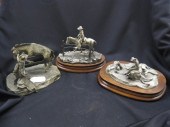 3 Chilmark Pewter Western Figurines
3 Chilmark Pewter Western Figurines includes ''Getting Acquanted'' and rider on horseback along a barbed wire fence by Donald Polland together with a man trying to saddle a wild horse by Philip Kirczkowski most 7'' size.
3 Chilmark Pewter Western Figurines
3 Chilmark Pewter Western Figurines includes ''Getting Acquanted'' and rider on horseback along a barbed wire fence by Donald Polland together with a man trying to saddle a wild horse by Philip Kirczkowski most 7'' size. -
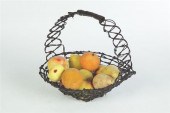 GROUP OF STONE FRUIT. Probably
GROUP OF STONE FRUIT. Probably American late 19th-early 20th century. Fourteen pieces of assorted fruit including pears apples oranges and figs with original polychrome coloring. Placed in a later basket made from barbed wire. 12 1/4''h.
GROUP OF STONE FRUIT. Probably
GROUP OF STONE FRUIT. Probably American late 19th-early 20th century. Fourteen pieces of assorted fruit including pears apples oranges and figs with original polychrome coloring. Placed in a later basket made from barbed wire. 12 1/4''h. -
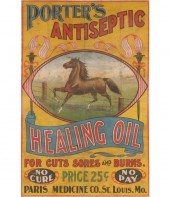 Equine veterinary remedy poster;
Equine veterinary remedy poster; Porter's Antiseptic Healing Oil mfg. by Paris Medicine Co., vibrant color on canvas/oil cloth depicting horse in barbed wire, late 19th-early 20th C. 35" x 23". Fold lines, soiled surface, several tears in field.
Equine veterinary remedy poster;
Equine veterinary remedy poster; Porter's Antiseptic Healing Oil mfg. by Paris Medicine Co., vibrant color on canvas/oil cloth depicting horse in barbed wire, late 19th-early 20th C. 35" x 23". Fold lines, soiled surface, several tears in field.
...many more examples with full details are available to our members - Learn more


